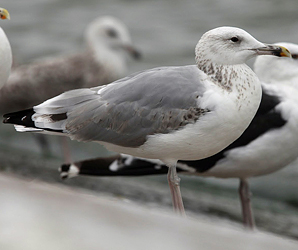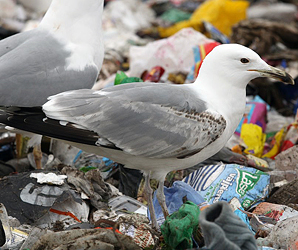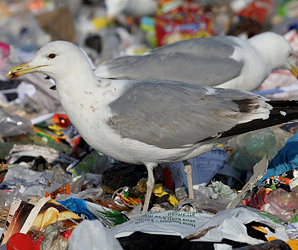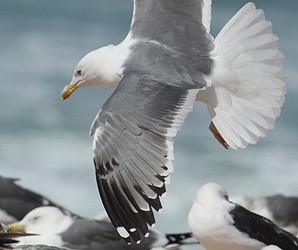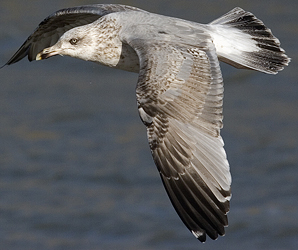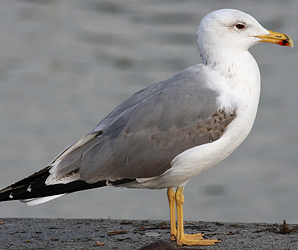 Larus cachinnans
Larus cachinnans
(last update:
Greg Neubauer
Marcin Przymencki
Albert de Jong
Mars Muusse
In 2010, Chris Gibbins, Brian J. Small and John Sweeney published two extensive papers in Britsih Birds, dealing with Caspian Gull. Below, you will find the content of the first paper "Part 1: typical birds".
Part 1: INTRODUCTION & IDENTIFICATION
Part 2: JUVENILES (1CY birds in July–September)
Part 3: BIRDS IN THEIR FIRST WINTER (1CY/2CY birds in October–April)
Part 4: BIRDS IN THEIR FIRST SUMMER (2CY birds in May-September)
Part 5: BIRDS IN THEIR SECOND WINTER (2CY/3CY birds during October-April).
Below, we continue with PART 6: Older immature plumages (3CY–5CY birds). "we" in the text below refers to the original authors. If any errors occur in this text, please let me know and mail to marsmuusseatgmaildotcom.
Older immature plumages (3CY–5CY birds)
Moult and plumage development
The second complete moult takes place
during the summer and autumn of the third
calendar-year and brings in new, pure grey
feathers to the mantle, wing-coverts and tertials.
The third-generation primaries have
small white tips (unlike first- and second-generation
ones), as well as large mirrors on
P10 and, most frequently, also on P9. The
outer primaries are otherwise blackish and
the inner ones have adult grey tones. Once this moult is complete, birds can be regarded
as being in third-winter plumage (here, here & here) and, overall, they show a greater
resemblance to adult than earlier immature
plumages. The upperparts are largely grey,
with variable amounts of brown retained in
the tertials and coverts. This plumage is
retained over the winter and following
spring/early summer, when the third complete
moult takes place. This brings fourth-generation
primaries and fully adult
upperpart tones; normally, the only traces of
immaturity are dark marks in the primary
coverts and on the bill. The following text
deals primarily with third-winter birds, but
provides some information and illustrations
of fourth-winter individuals.
Once the second complete moult is finished (and third-winter plumage attained), the mantle and scapulars are generally adult grey, while the coverts are most frequently a mixture of grey and creamy-brown. There is much variability in the coverts, with some birds having wholly grey feathers. Brown feathers tend to be retained more in the marginal and lesser coverts, with the medians and greaters being contrastingly grey. The tertials are either all adult-like or have some brown patches. The outer primary coverts and the alula also retain extensive, blackish brown marks (plate 82). The secondaries of some birds have small, neat brown centres forming a broken bar. The tail pattern is extremely variable. Frequently there is an obvious vestigial tail band created by isolated black spots, rather like that of second-winter Ring-billed Gull L. delawarensis; such tail bands also occur in michahellis but are very rare in third-winter Herring Gulls. Some third-winter cachinnans, however, have a wholly white tail.
Although not yet the full adult pattern, the third-generation primaries of cachinnans offer useful identification clues. There is a broad, complete black band across P5 and usually some black on P4, either on both webs or just the outer. Third-winter birds that have limited or no black on P5 are unlikely to be cachinnans or michahellis. The white mirror on P10 can be a useful distinction from michahellis: in terms of size and prominence, the P10 mirror of most third-winter cachinnans matches that of an adult michahellis (much larger than on third-winter michahellis, which have either no mirror or only a small one). Most third-winter cachinnans also show a white mirror on P9, unlike michahellis (but see plate 84). Third-winter Herring Gulls can also show a reasonably large mirror on P9 and P10; argentatus can show a long white tip to P10, with only a small dark subterminal smudge (plate 86). Thus, the patterns on P9 and P10 are not diagnostic of third-winter cachinnans and are more useful for ruling out michahellis than Herring.
On some third-winter cachinnans, the middle primaries (P6–P8/P9) have black that extends further up the outer web than the inner; this gives the impression of grey 'tongues' cutting into the black of the wingtip, a pattern that develops more strongly in adults. This is very different from argenteus Herring Gulls and especially michahellis (plate 84), both of which show a solid, triangular black wedge across the wing-tip. Not all cachinnans have the distinctive tongued pattern, and so match michahellis and Herring Gull. Both cachinnans and michahellis show dark marks on the alula and primary coverts, which tend to be blacker and more clearly defined than in Herring Gull.
The head of cachinnans tends to be clean white, lacking distinct streaking. In autumn and early winter, a relatively neat half-collar of dark streaks is usually visible on the hindneck and can make cachinnans distinctive even at a distance. This streaking wears away as the winter progresses. Herring Gulls have more widespread, diffuse and blotchy head and neck streaking. The head streaking of 3CY–4CY michahellis in winter is often concentrated around the face rather than restricted to the hindneck.
In the summer of their fourth calendar year,
the third complete moult brings in
fourth-generation primaries. Once this is
complete, birds are generally regarded as
being fully adult, although some retain dark
markings on the bill and black in the primary
coverts and at the tip of P10. Confident
ageing of such birds is difficult, however,
since dark marks in the primary coverts and
small areas of black in the bill are occasionally retained well into full adulthood. The fourth-generation primaries of cachinnans are similar to those of adults, with a long
white tongue on the underside of P10 and
grey tongues eating into the black wing-tip
on the upperside of P8–P10.
Bare parts
The third-winter bill has a mix of blackish
brown and paler areas. Black is usually confined
to the gonys region as a diffuse 'thumbprint',
with a paler tip and basal third to the
bill. Some isolated darker smudges are often
present closer to the base, and many have a
little black bleeding along the cutting edge
from the gonys. The pale parts of the bill are
most frequently a dull greeny yellow, typically
with a strong grey cast. Some have
rather more yellow-toned bills. Red is not
prominent in the gonys of cachinnans of this
age. The legs are invariably a rather colourless,
dead-flesh grey, compared with the
pinker legs of Herring Gulls. The legs of
third-winter michahellis are usually greeny-yellow
or grey-yellow, with some having clear
yellow tones; they can, however, occasionally
be dull flesh-coloured as in cachinnans. The
eyes of most cachinnans still look dark
brown, but slightly paler irides may develop
from this age onwards. Most but not all michahellis and Herrings of this age have
paler (greeny- or greyish-yellow) eyes. It is
rare for cachinnans of this age to have very
pale (cream or yellow) eyes, and such birds
should be scrutinised closely. Eye-ring colour
tones of third-winter birds also begin to
reflect those of adults (see below).
Pitfalls
Despite often looking distinctive, third-winter
and third-summer birds have no truly
diagnostic plumage features. In essence, the
distinctive features of younger birds have
been lost, while the adult wing-tip pattern
has not developed sufficiently for it to be
considered critically important. Identification
should be based on a careful assessment
of structure, in combination with indicative
plumage features listed above, and the
absence of anomalies.
Some cachinnans of this age can be particularly tricky to separate from michahellis. Near-adult michahellis often have dark eyes and smaller individuals can have bill shape and overall jizz reminiscent of some cachinnans. Some cachinnans lack grey tongues in their third-generation primaries and so overlap with michahellis; however, they should have larger mirrors than michahellis. Long call and associated posture are the best way to separate the more difficult individuals.
Experienced gull-watchers are unlikely to
mistake third- and fourth-winter Herring
Gulls for cachinnans, but others should be
aware of the problem posed by argentatus.
Some late-winter argentatus are clean-headed
and share some aspects of the cachinnans wing-tip pattern – with a long white tip to
P10 and grey tongues that invade the black
wing-tip. While the irides of most Herring
Gulls will be rather pale by their third winter, a significant proportion retain dark eyes: a
clearly pale eye in a near-adult gull is not
good for cachinnans but a dark eye does not
automatically rule out Herring Gull.
END OF PART 6
CONTINUE AT PART 7: ADULTS
 Larus cachinnans 2CY-5CY UKK T-001874 May 2010 - July 2013, Windheim & Deponie Pohlsche Heide - Minden, Germany.
Picture: Armin Deutsch.
Larus cachinnans 2CY-5CY UKK T-001874 May 2010 - July 2013, Windheim & Deponie Pohlsche Heide - Minden, Germany.
Picture: Armin Deutsch.  Larus cachinnans hybrid? 2cy-3cy PLG DN-25884 October 2009 & September 2010, Westkapelle, the Netherlands. Picture: Theo Muusse.
Larus cachinnans hybrid? 2cy-3cy PLG DN-25884 October 2009 & September 2010, Westkapelle, the Netherlands. Picture: Theo Muusse. Larus cachinnans 2CY-3CY SKB E1711 January 2013 - September 2014, the Netherlands & Germany.
Larus cachinnans 2CY-3CY SKB E1711 January 2013 - September 2014, the Netherlands & Germany. Larus cachinnans 3CY, September 24 2010, Westkapelle, the Netherlands. Picture: Maarten van Kleinwee.
Larus cachinnans 3CY, September 24 2010, Westkapelle, the Netherlands. Picture: Maarten van Kleinwee.
